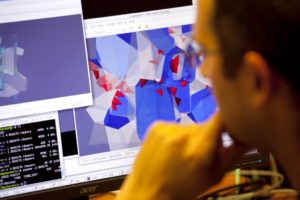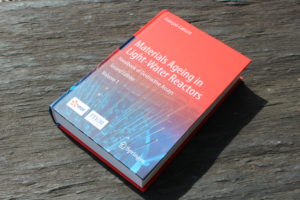Predictive tools for Long Term Operation is one of the central activities of the MAI

Predictive tools for Long Term Operation is one of the central activities of the MAI. Mathematical models not only allow us to test our understanding of fundamental processes such as stress corrosion cracking, corrosion fatigue and creep – they also enable us to capitalize on our knowledge through parameter databases. Furthermore, they are of key importance in assessing the durability of components and materials for periods beyond reasonable duration and under conditions beyond experimental reach. The Institute has one of the most powerful supercomputers owned by a non-government organization. This computer power greatly speeds up complex numerical simulations, including dislocation dynamics, molecular dynamics, ab initio modelling, Monte Carlo simulations, as well as simulation of complex 3D structures of materials. Simulations which used to take about one month of computation time can now be performed in a few hours.
The more than 40 years operating experience and plant life management expertise represented by the members of the MAI represent a unique and valuable resource for the study of materials aging mechanisms. Operational feedback data are obtained using samples of material that are made available by utilities after the replacement of specific components.
Code CORIOLIS
CODE CORIOLIS has been developed by EDF R&D to predict Stress Corrosion Cracking (SCC) kinetics and location in 3D structures. The simulation is based on a fast post finite element modeling analysis chaining IGSCC initiation and crack growth models. Code_Coriolis offers new possibilities for various type of users :
– for researchers : better calibrate and validate SCC models, with a global 3D view, by-resimulating SCC lab tests
– for engineers and end-users : better predict SCC in large industrial components (modeled in 3D), as a support to examinations on retired components or for parametric studies.
Our first computations demonstrated that SCC can be simulated at the scale of a ‘large’ component thanks to a physically-based model relying on local observations (SEM, TEM) and small scale simulations (crystal plasticity). Our efforts are currently being addressed on the validation of the developed methodology, based on mockup characterizations and operational experience.
See our last benchmark between CORIOLIS and xLPR (below)
Code C3D
C3D is a finite element code for the numerical simulation of the eddy current inspection of steam generator tubes. The model is fully 3D and is capable to model the straight and expanded section of SG tubes, as well as their environment, such as anti-vibration bars or support plates. The code is also able to model deposits on tubes, and to simulate any kind of defect geometry. As opposed to general purpose codes, C3D comes with a comprehensive probe library, including bobbin probes, differential probes, and multiple bobbin probes. A dedicated graphical user interface facilities the creation of configurations and hides part most of the complexity usually involved in finite element codes. The code is available as a web service.
Code MODERATO
MODERATO is a software package for the computer modelling of industrial radiography from source to radiogram. It combines Monte-Carlo and straight line attenuation models with an intuitive user interface, making radiography modelling an accessible tool on a personal computer. However, as with all simulation programs, a thorough understanding of the inner workings of MODERATO is necessary to fully exploit the package.
Code ATHENA
Athena 4/Milena 4 is a comprehensive 2D ultrasound NDE modeling package, comprised of the finite element engine Athena2D and the graphical user interface Milena. As opposed to general finite element engines, Athena explicitly targets ultrasound NDT, and uses commonly used parameters to define a given inspection configuration.
Code Vi(CA)2T
Vi(CA)2T (Virtual Cement and Concrete Aging Analysis Toolbox) is a software virtual lab dedicated to cementitious materials. From the mix design details and aging conditions, it is able to estimate engineering properties, such as the evolution of hydration heat, capillary porosity, water amount or dielectric permittivity; and constitutive behaviours, such as the evolution of Young’s modulus or basic creep. The tool takes advantage of the most recent advances in homogenization of random media, to efficiently provide results without requiring intricate 3D microstructural models. Typical use cases include providing relevant material properties for FEM civil engineering computations, and building calibration curves to help interpret raw NDT results.


 Discover the Handbook of material ageing management for nuclear reactors
Discover the Handbook of material ageing management for nuclear reactors